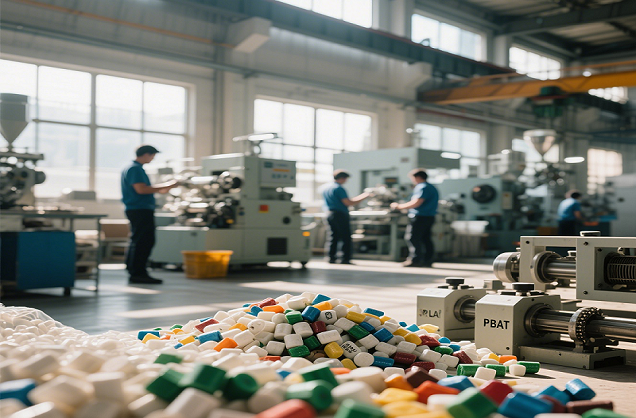Analysis of the Development Prospects of Biodegradable Materials PLA and PBAT
As the global environmental protection awareness increases, the problem of plastic pollutants is becoming more and more serious, and the non-degradability of traditional petroleum-based plastics has caused a huge burden on the environment. In this context, biodegradable materials such as poly(lactic acid) (PLA) and poly(adipic acid)/butylene terephthalate (PBAT) have received widespread attention due to their environmentally friendly properties.

Development Status and Prospects of PLA
1. Technical characteristics and advantages
PLA (polylactic acid) is a bio-based biodegradable plastic synthesized from renewable plant resources such as corn and sugarcane, with the following characteristics:
Biodegradability: under industrial composting conditions (50-60°C, high humidity), PLA can be completely degraded to CO₂ and water within 6-12 months.
Good mechanical properties: PLA's strength is close to that of polystyrene (PS), making it suitable for packaging, tableware, 3D printing, etc.
Low carbon emission: Compared with traditional plastics, PLA production process reduces carbon emission by about 60%.
2. Market applications
PLA is currently mainly used in:
Food packaging (such as disposable tableware, cling film)
Medical field (absorbable suture, drug slow-release carrier)
Textile industry (environmentally friendly fibers)
3. Development prospects
Policy-driven: EU “plastic ban”, China's “plastic restriction” and other policies to promote the growth of PLA demand, the global PLA market size is expected to exceed 5 billion U.S. dollars in 2025 (CAGR 15%).
Technological progress: through the blending modification (such as PLA + PBAT) can improve its brittleness, heat resistance, and expand the application scenarios.

Development status and prospect of PBAT
1. Technical characteristics and advantages
PBAT (polybutylene terephthalate/adipic acid) is a petroleum-based biodegradable plastic, but it is still compostable due to its molecular structure design:
Highly ductile: PBAT is more flexible than PLA and is suitable for film products (e.g. plastic bags, mulch).
Rapid degradation: Under natural composting conditions, PBAT can be degraded within 3-6 months.
2. Market applications
The main applications of PBAT include:
Agricultural mulch film (replacing traditional PE mulch film, reducing white pollution)
Packaging film (shopping bags, express bags)
3. Development Prospects
Cost advantage: PBAT's production process is mature, and the cost can be reduced to 15-20,000 yuan/ton after scale-up, which is close to that of traditional PE plastics.
Policy dividend: China's “14th Five-Year Plan” lists PBAT as a key material for development, and the production capacity is expected to exceed 1 million tons in 2025.

Challenges faced by the industry
Despite the promising future of PLA and PBAT, the following problems still exist:
1. Higher costs: PLA raw materials (e.g. corn) are subject to price fluctuations, and the petroleum-based properties of PBAT are affected by oil prices.
2. Restricted degradation conditions: specific composting environments are required, and degradation in natural environments is slow.
3. Inadequate recycling system: insufficient sorting and recycling facilities may affect the actual environmental protection effect.
Future Trends
1. Material composite: PLA and PBAT mixing can take into account the strength and flexibility, becoming the mainstream direction.
2. Industry chain integration: from raw materials (such as biomass fermentation) to the end product of the whole chain layout will reduce costs.
3. Policy standardization: countries need to unify the degradation certification standards (such as EN13432, ASTM D6400), to avoid the “pseudo degradation” chaos.
Conclusion
PLA and PBAT, as representatives of biodegradable materials, will usher in rapid growth under the promotion of policy and technological progress. In the future, through technological innovation, large-scale production and perfect recycling system, we need to further reduce the cost and improve the performance, and ultimately realize the large-scale substitution of traditional plastics. The global biodegradable plastics market is expected to exceed $20 billion in 2030, and PLA and PBAT will become the core driving force of this change.
 For PLA/PBAT biodegradable mat
For PLA/PBAT biodegradable mat
 Price war! PBAT raw material p
Price war! PBAT raw material p
 PBAT degradation speed increas
PBAT degradation speed increas
 From Policy to Practice: Impli
From Policy to Practice: Impli
CONTACT
Add: Room 4006, No.1 Helong Yiheng Road, Baiyun District, Guangzhou City
Tel: +8613450255948
Wechat : +86-13450255948
Fax: +86-13450255948
E-mail: 13450255948@163.com








